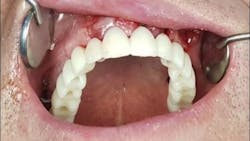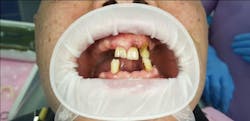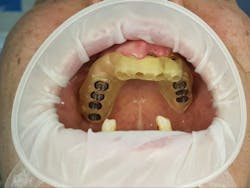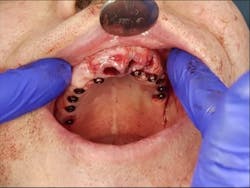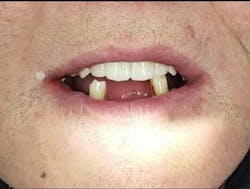5 questions to ask before choosing between delayed and immediate dental implant loading
Dental implants are the treatment of choice for replacing missing teeth, and many times patients want to have their new ones supported on implants as soon as possible. The conventional wisdom is that dentists wait four to six months after placing an implant before attaching a suitable prosthesis over it. There is a gradual trend toward loading implants immediately after placement; however, there are benefits and limitations for both loading protocols. In this article, we will discuss five questions dentists need to consider before deciding on the right path for treatment. First, let’s take a step back and look at the protocols for delayed and immediate dental implant loading.
Delayed implant loading
Conventional implant loading involves loading an implant with a prosthesis after a healing period of four to six months following its insertion. The delayed implant loading procedure was originally developed by Dr. Tomas Albrektsson in 1981 for implants with machined surfaces.1 During the first stage of this protocol, a surgical flap is raised, the implant is inserted into the bone, and the flap is sutured back into position. After about six months, when osseointegration has taken place, the surgical site is exposed again to uncover the implant. In a relatively short amount of time, the gingiva heals, an impression is taken, and the missing teeth are restored.
Immediate implant loading
Immediate implant loading requires functional occlusal loading of an implant within 48 hours of its insertion. In contrast to conventional loading, immediate loading considerably reduces the waiting period between implant insertion and loading, as well as the number of visits to the dentist. The assumption is that an initial primary stability can be achieved in the old bone and will change over time into secondary stability in new and osseointegrated bone.2
Questions to ask before deciding on the treatment path
There are five questions that dentists should ask themselves to determine whether to recommend delayed or immediate implant loading to their patients.
No. 1. How important are the esthetics of the implanted teeth?
It is natural that patients want to have their teeth restored sooner rather than waiting the conventional four to six months required for delayed implants. When esthetics are a consideration, such as teeth that are visible when patients talk or smile, dentists are compelled to deliver immediate solutions. These can be based on immediate loading or other temporary restorations such as a Maryland bridge, for example. In situations where the teeth are in nonvisible areas and need to withstand greater occlusal loads, the safer approach is to implement delayed implant loading.
No. 2. What is the condition of the patient’s oral hygiene?
Although poor oral hygiene is not an absolute contraindication for implant therapy, immediate implant loading is not advisable for patients with poor oral hygiene. It can affect periodontal health, quality of bone, and directly affect the osseointegration potential of an implant.3
No. 3. What is the occlusion and wear pattern of the patient’s teeth?
Successful osseointegration of dental implants is highly dependent upon the magnitude of forces they must endure after loading. Studies show that rigid splinting stabilization is a crucial factor for successful immediately loaded implants. If splinting is lost, implant failure is likely to occur by uncontrolled masticatory forces.4 Dentists should carefully assess the occlusion and wear pattern of the patient during treatment planning. If a patient has parafunctional habits or very high masticatory forces, immediate loading of the implant should be avoided as it can disturb healing and osseointegration.
No. 4. How much bone grafting is required?
Once the optimal position of an implant has been decided, dentists need to examine the site from a surgical standpoint. Is soft tissue or bone augmentation required for implant placement? When the movement of an implant occurs beyond a certain threshold, ossoeintegration and mechanical stability are seriously affected as a result of disturbance to surrounding bone and vascular tissues.
If there is a significant need for bone grafting, it is better to use an implant with a larger diameter or employ a delayed loading protocol. Some studies have found no difference in immediate loading compared to delayed loading when used with bone grafting5; however, you should keep in mind that the stability of an implant with a bone graft is lower. In cases of type IV bone, which is thin and of low density, you should implement delayed implant loading.
No. 5. What implant surface treatment are you using?
Implant surface directly affects the early osseointegration potential of dental implants as the coating thickness decreases over time.6 Implant manufacturers favorably modify implant surfaces to increase the rate of osseointegration as well as the onset of primary and secondary stability. Specifically, implants coated with hydroxyapatite and other bioactive materials will significantly reduce the time required for osseointegration, and thus enable immediate implant loading.
When should you use each protocol?
It can be difficult to establish which loading protocol is better, and the choice for implant loading varies with each patient. Research has shown that immediate implant loading may be successful in the following clinical situations:
• Edentulous maxilla—when fixed prostheses are used
• Edentulous mandible—treatment is successful with both removable and fixed appliances
• Single-tooth replacement in esthetically critical zones
• Short-span fixed partial dentures
First stage: We would fix the first guide to the anterior teeth (tooth-supported guide) and place the posterior implants.
Second stage: We would extract the teeth, fixing the second guide to the gingiva (tissue-supported guide) and place the anterior implants.
And after all that, we would fix the screw-retained bridge.
With that said, immediate loading protocol should only be considered when there is enough bone available, parafunctional habits are absent, and the patient has excellent oral hygiene. Further research is still required to optimize treatment protocols and produce materials for implant surface coating, which accelerate osseointegration and implant stability.
You must evaluate each patient before formulating a treatment plan. Although immediate implant loading significantly reduces the number of dental visits and the waiting periods for loading, this protocol is not suitable for every clinical situation and must be assessed carefully. When in doubt, the time-tested delayed loading protocol can be used in all types of clinical situations, and it should be the go-to solution to ensure patients are satisfied with their implants over the long term.
References
1. Albrektsson T, Brånemark PI, Hansson HA, Lindström J. Osseointegrated titanium implants: requirements for ensuring a long-lasting, direct bone-to-implant anchorage in man. Acta Orthop Scand. 1981;52(2):155-170. doi:10.3109/17453678108991776
2. Raghavendra S, Wood MC, Taylor TD. Early wound healing around endosseous implants: a review of the literature. Int J Oral Maxillofac Implants. 2005;20(3):425-431.
3. Porter JA, von Fraunhofer JA. Success or failure of dental implants? A literature review with treatment considerations. Gen Dent. 2005;53(6):423-432.
4. Nkenke E, Lehner B, Weinzierl K, et al. Bone contact, growth, and density around immediately loaded implants in the mandible of mini pigs. Clin Oral Implants Res. 2003;14(3):312-321. doi:10.1034/j.1600-0501.2003.120906.x
5. Kinaia BM, Kazerani S, Korkis S, Masabni OM, Shah M, Neely AL. Effect of guided bone regeneration on immediately placed implants: Meta‐analyses with at least 12 months follow up after functional loading. J Periodontol. 2019. doi:10.1002/JPER.18-0543 Published online January 14, 2019 ahead of print.
6. Chang YL, Lew D, Park JB, Keller JC. Biomechanical and morphometric analysis of hydroxyapatite-coated implants with varying crystallinity. J Oral Maxillofac Surg. 1999;57(9):1096-1108. doi:10.1016/s0278-2391(99)90333-6
Editor's note: This article originally appeared in Breakthrough Clinical, a clinical specialties newsletter from Dental Economics and DentistryIQ. Read more articles at this link.
About the Author
Yaniv Skvirsky, DMD
Yaniv Skvirsky, DMD, serves as the vice president of research and development at XGate Dental, a manufacturer of dental implants and prosthetic devices, where he is responsible for the development and implementation of product designs. Prior to working at XGate, Dr. Skvirsky worked as a dental laboratory technician and an R&D manager for his own company. To learn more, visit https://xgate.dental/ or email [email protected].
